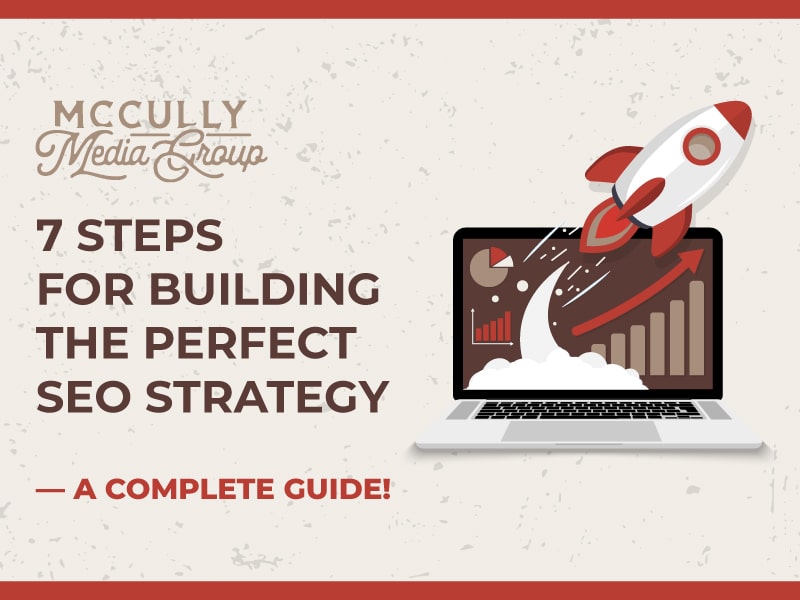Three letters will change the way you market your business forever. SEO — or search engine optimization — is something you can no longer ignore. It can help your web pages enjoy higher visibility within Google and other search engines. The higher your pages rank, the more visitors they will have. This is why it’s crucial that you learn how to build an effective SEO strategy.
It is a fact that three-quarters of people never even scroll past the first page of Google. That’s why you need SEO. It’s the process of organizing your website’s content to improve its chances of appearing on the first page of search results. You can greatly increase awareness about products and services by using this marketing method.
Ready to build your SEO strategy? Here’s what you need to know.
How to Build an SEO Strategy: Why You Need an SEO Strategy

So, you have a business and want to generate more traffic to your website. You could invest in digital marketing — that includes methods like email marketing automation, social media marketing, and paid search. But while these techniques can be successful, excluding an SEO strategy is usually a huge mistake.
SEO is the foundation of digital marketing because most internet experiences start with a search engine. Having an SEO strategy will help to ensure your website appears in a prominent place on the search engine results pages (SERPs). This will allow people to find you.
We know what you’re thinking. “Why create an SEO strategy when I can pay for my website to appear at the top of search engine results?”
Well, driving traffic to your site isn’t as simple as that. Sure, you could invest in paid ads and wait for people to click on your site. But paid ads complement organic search (unpaid search rankings influenced by SEO) when you sync these methods.
Even if you have a great pay-per-click (PPC) campaign, you’ll miss out on high-quality traffic if you overlook SEO.
It’s your choice. But having some kind of SEO strategy is the best course of action. SEO can help most businesses increase website traffic, regardless of size or industry.
How to Build an SEO Strategy: Benefits of an SEO Strategy

These are some of the most critical benefits of a thoughtful SEO strategy:
Greater credibility
Think about your own search experiences when coming up with an SEO strategy. You’re more likely to click on a website that appears near the top of the first page of the search engine results page, right? In fact, you might not even look at those further down the list or on page two. That’s because we all perceive the sites at the top of page one to be the most credible.
That’s not always the case, of course. But pages that rank high on a SERP are almost always trustworthy and high in quality.
We trust Google (and other search engines) to display the most authoritative sites at the top of its SERPs. Hence, if you want your site to appear more credible, you need to invest in an SEO strategy. It’s that simple.
Your strategy will involve making changes to your website. These changes can enable your site to join all the other prestigious sites at the top of the food chain.
Increased awareness
Have you heard this famous phrase?
“If a tree falls in a forest and no one is around to hear it, does it make a sound?”
The premise is kind of the same for an online business. Even if you offer the best products and services in the world, it doesn’t mean much if nobody can find them. You need traffic from search engines so consumers can discover your site. Then they will realize you have a great company and can purchase your products and services. Google, for example, has over 270 million unique visitors in the U.S. That’s an enormous audience that only an SEO strategy can help you reach.
By making some changes to your website’s structure and content, you can increase awareness of your company. You could also generate more traffic than you ever imagined!
Cost efficiency
We mentioned earlier that paid ads are costly. But did you know that some businesses spend thousands of dollars on Google AdWord campaigns and other paid search programs? That’s a lot of money if you have a small company.
The great thing about SEO is that it’s free. It won’t cost you anything to optimize your website for search engines.
Creating an SEO strategy is also free if you do it yourself. However, working with a reputable digital marketing agency typically generates more explosive results. It is significantly easier and faster because you work with talented professionals who know SEO like the back of their hands.
While this process requires an outlay, it doesn’t have to be expensive. The best agencies will create an SEO strategy based on your business budget and requirements. And you won’t waste money on paid search campaigns that don’t produce results.
Improved measurability
Sometimes, it’s hard to know whether your digital marketing investment is paying off. Some marketing techniques are notoriously difficult to measure. You may have no idea if you’re doing well or not.
Creating an SEO strategy does the opposite. As you build your strategy, you can track its success with the latest digital analytical tools. This helps you find out what SEO elements generate a return on investment.
Google Analytics, for example, lets you identify trends and patterns in SEO data. You can then make better decisions about your marketing campaigns.
Enhanced user experience
While an SEO strategy is all about making your website more “searchable,” it serves a second purpose. Optimizing your site for Google and other platforms makes it more user-friendly for your existing customers.
Here’s an example:
Designing your website to display correctly on smartphones is one of the most critical factors for successful SEO. However, this process — known as mobile optimization — will also make your site more accessible for customers who browse it on a mobile device.
There are other parts of an SEO strategy that will inadvertently improve the user experience:
• Changing your website structure to make it more SEO-friendly will help customers navigate and find content on your site.
• Creating more content for your site helps search engine bots crawl, categorize, and rank that content. It also provides customers with valuable information about your products, services, industry, and topics that interest them.
• Optimizing your website speed so search engines find your site more desirable will allow customers to access content more quickly.
How to Build an SEO Strategy: 7 Steps for Creating an SEO Strategy

Now that you know the benefits of an SEO strategy, it’s time to create one for yourself!
1. Perform an SEO audit
The word “audit” might terrify you — especially if you’ve ever been investigated by the IRS. However, in an SEO context, an audit is almost always a good thing. It identifies how well your website performs against current SEO best practices and standards. That helps you plan the next steps of your SEO strategy.
You can perform an audit yourself or hire an experienced digital marketing agency to do it for you. Either way, an audit will:
• Check the effectiveness of web page elements such as domains, headers, meta tags, subheaders, and keywords.
• Determine the success of your website structure and navigation.
• Review website structural elements like sitemaps, site architecture, and site schema.
• Identify new inbound and outbound linking opportunities for your web pages.
There’s much more to an SEO audit than all this. But you can see how important it is when creating your strategy.
2. Plan your road to SEO success
Once you know the current state of your website, you can get into the nuts and bolts of your SEO strategy. Ask yourself the following questions before making any changes to your site:
• How much do you want to spend on SEO?
• How long will it take you to improve your search rankings?
• Will you execute your SEO strategy alone or with the help of SEO professionals?
• What key performance indicators (KPIs) will determine the success of your SEO strategy?
• What SEO elements will you invest in? Content marketing? Keyword research? Analytics?
Your answers will help you fine-tune your strategy and determine a budget and timeframe for SEO success. If you’re working with SEO professionals, give them the answers to these questions so you can plan your strategy together.
3. Analyze the competition!
Put on your detective hat and enhance your strategy by investigating how other companies execute SEO. This process is “competitive analysis.” It can be valuable if your rivals rank higher on SERPs than you but you don’t know why!
Here are some tips for competitive analysis:
• Choose competitors in your niche or location with a better search presence than you. (Companies that appear higher on SERPs for desirable keywords.)
• Check out their websites and see how they differ from yours. Do these companies present information in a distinct way? Do they create more content than you? What type of website structure do they use?
• Read online reviews — an essential ranking factor in SEO — for these companies and see what customers say about them. Do your rivals generate more positive feedback than your business? If so, why?
• Use SEO tools to discover what keywords these companies use in their content.
4. Start thinking about keyword research

Google and other search engines continuously change their algorithms when determining ranking factors for SERPs. Despite this, keywords still reign supreme.
In other words, the better your keywords, the better the chances of your site appearing in a prime position on search engines. A massive 71% of marketers say using strategic keywords is their No.1 SEO strategy. Keyword research or optimization should be the bedrock of your SEO strategy, too.
So, where do you start with keywords? Well, they need to be relevant. That means incorporating keywords into web pages, blog posts, and meta descriptions to inform search engines of what your content is about.
Basically, SEO is all about search engines crawling your content for keywords they determine to be “relevant.”
While “relevancy” might be a vague term, it refers to keywords that match a user’s search query. Say someone searches for “hotels in Austin.” Google will crawl the internet for that term and similar search terms like “Austin hotels.” If your content includes keywords like this, your website will appear higher on Google’s SERPs than a website that doesn’t.
Marketers refer to this process as “search intent.” People search for specific content with keywords, and websites using these keywords satisfy those people’s needs.
Of course, sorting keywords involves more than all this. You’ll need to consider long-tail keywords, semantic keywords, and funnel keywords. This is where things can get complicated. It’s also why working with qualified SEO experts who also provide specialized digital marketing advice is a good idea. You can build a more successful SEO strategy as a result.
5. Align your SEO strategy with your customers
You don’t win a prize for taking the No.1 position on a SERP for a desired keyword. SEO, at its core, is about improving your website to attract more customers. You can stuff content with all the keywords you like. You can generate a good ranking on Google. But if that content is worthless, visitors will only hit the “back” buttons on their browsers.
That’s what many businesses forget when building an SEO strategy. Ultimately, all changes you make to your site are for the benefit of people, not search engines.
Before you optimize your site, align your SEO strategy with customers’ needs. By “customers,” we mean new and existing ones. These include the people who don’t know anything about your business. These also include the people who have previously purchased your products and services.
You can align your strategy with customers by asking yourself these questions:
• What information do people want when using a search engine? And can you provide them with that information? If the answer is yes, optimize your site to fulfill their needs.
• What do people expect when they click on your website from a search engine? They probably have a problem that you can solve. Optimize your site and provide them with the solution they need.
6. Be specific about SEO
You have already allocated your budget and generated a timeline for successful SEO. Now it’s time to think about the specific changes you will make to your website to rank higher in the SERPs.
You know you want to attract more customers from search engines, but how will you do it? What keywords will you use? What SEO elements will you invest in?
Your final strategy might look something like this:
Month 1: Carry out an SEO audit, keyword research, and competitive analysis. Discuss the results of these experiments with your team.
Month 2: Start creating content for your website and blog pages based on your keyword research and competitive analysis. Fix broken links. Remove any duplicate content you’ve already published.
Month 3: Start optimizing the structure of your website. Update web page elements like domains, headers, meta tags, schemas, and sitemaps. Publish the first batch of your newly created content. Promote content on your social media channels. Start tracking your SEO strategy with analytics tools.
Month 4: Carry out more keyword research. Keep tracking your strategy. Restructure content if necessary. Reach out to industry influencers on social media to discuss sharing your content.
This timeline is just a guide. But allocating different SEO tasks to different stages in your strategy will help you slowly improve your rankings on SERPs.
7. Track your results
Tracking your strategy over time is one of the most critical elements of SEO. You’ll learn more about which SEO changes generate the best results with audiences. You can make changes to your strategy if something doesn’t work out.
SEO tools like Google Analytics will provide information about your campaigns, allowing you to track key metrics in real time. Here is just some of the information you can learn with these tools:
• Keyword rankings
• Click-through rates
• Bounce rates
• Impressions/views
• Domain authority
• Domain rating
• On-page optimization scores
• Organic market share
You need to track these metrics constantly as you strategize. That’s the only way to gauge the success of your campaigns. Tools such as Google Analytics can generate SEO insights and display them on reports, dashboards, summaries, and other data visualizations. You can share these insights with your team members for better collective decision-making.
Conclusion
Sixty-nine percent of marketers invested in SEO during 2021, proving that this marketing method is still just as important as it’s always been. Ignore it at your own peril!
The best route to SEO success lies in creating a measurable strategy that increases credibility and boosts awareness. You should also create a strategy that improves the user experience and doesn’t cost a lot of money to implement.
Follow the seven steps listed above when coming up with your strategy or work with a reputable expert to fulfill your SEO needs by building an effective SEO strategy for you and your organization.
Schedule a consultation with McCulley Media Group to revolutionize your SEO!
Learn More:
This Is How to Create a Profitable Content Marketing Strategy Using 7 Essential Steps
7 Steps to Creating the Perfect StoryBrand Narrative




